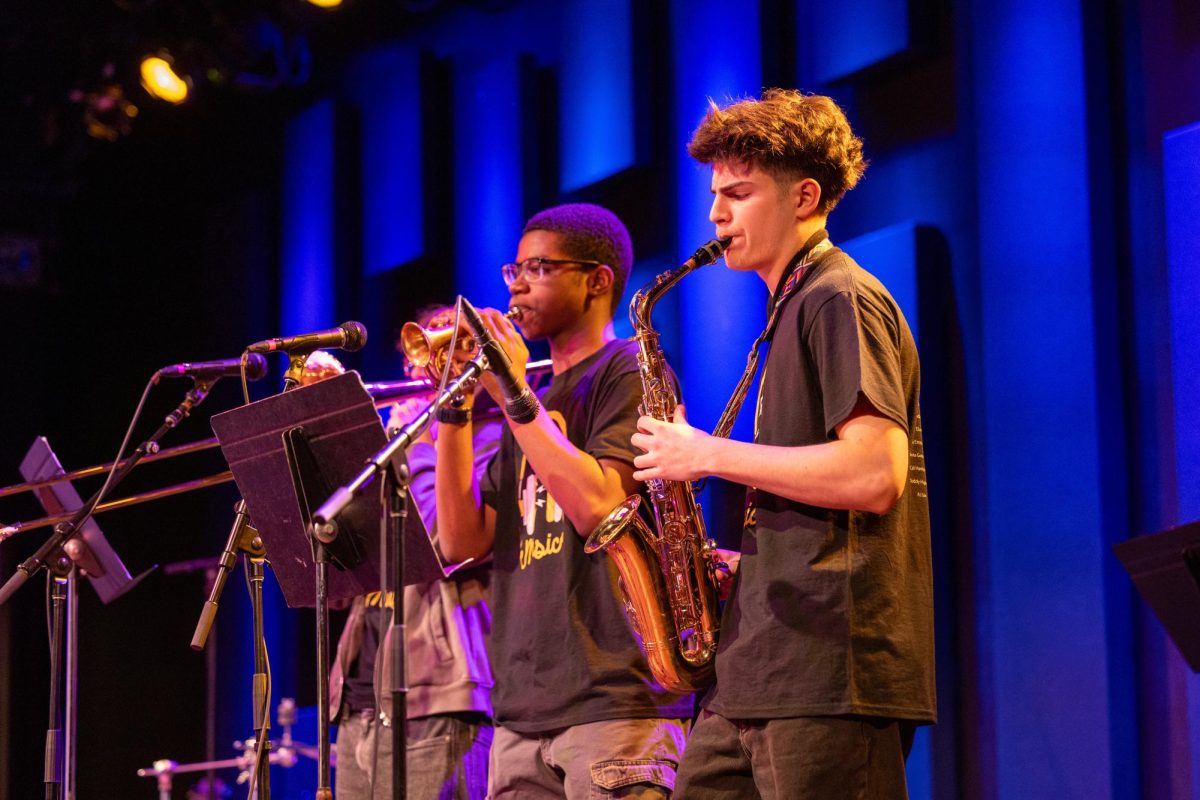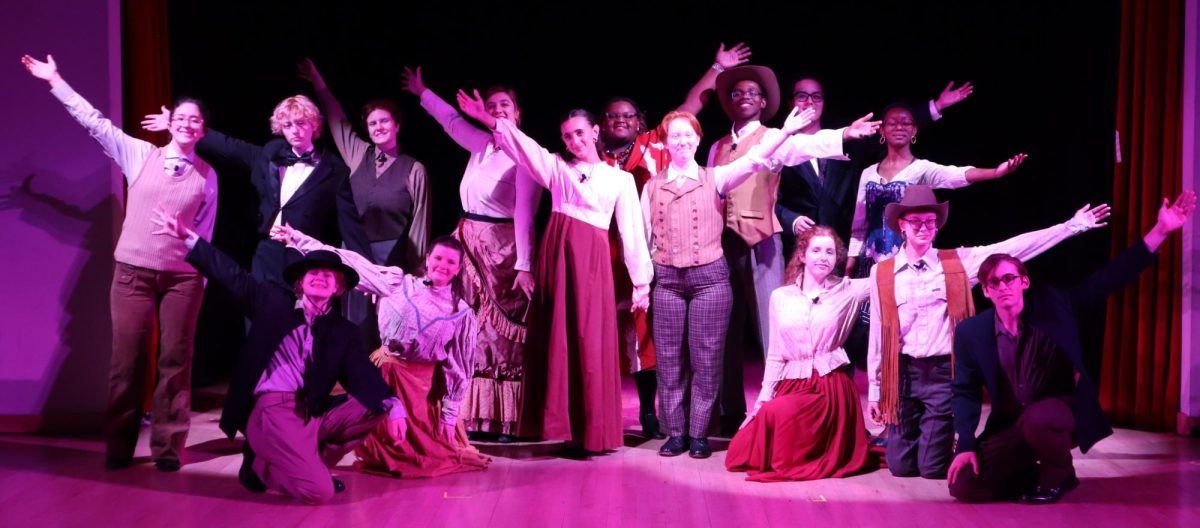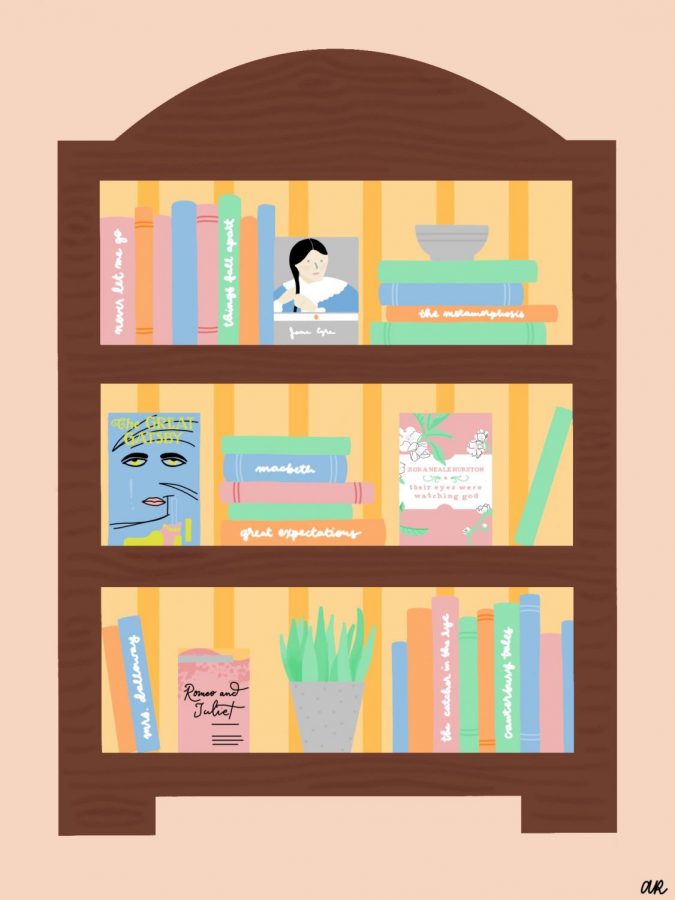The Best and Worst Books in the FSS English Curriculum
Illustrated by Annie Rupertus
With a set English curriculum for all students in ninth through eleventh grade, there are bound to be a variety of opinions on which books are good and which ones aren’t. We’ll be sharing reviews of some of our favorite—and least favorite—novels that we’ve read for English class at FSS.
Macbeth
Love, death, heartbreak, and plot twists. Despite Macbeth’s more than 400 years of existence, it is still witty and relatable. The play’s namesake, Macbeth, a Scottish earl, is a man on a mission. Full of ambition, he is heavily concentrated on his future and how he can someday become the King of Scotland. A perfectly written tragic hero, Macbeth is intrinsically human, and while his choices are questionable, it is impossible not to feel for him as his world falls apart. Macbeth’s wife, Lady Macbeth, is a real-badass and the true genius behind all of Macbeth’s successes and failures. Evil and strong, she breaks all stereotypes for a woman of Shakespeare’s time, and her pedantic rants about how much of a sissy her husband is are genuinely comical.
While some may argue that Shakespeare is outdated or no longer relevant to the modern classroom, Macbeth, despite its setting, is transcendent. It has an exciting plot, interesting characters, and is about the faults and flaws of humanity that affect us today and will continue to affect us forever.
(9.5/10)
Their Eyes Were Watching God
Although I technically haven’t finished reading Their Eyes Were Watching God, this novel 100% deserves to be on this list. Engaging and gorgeously written, Zora Neale Hurston’s novel explores themes of coming of age and the intersections of race, class, and gender in ways that are still interesting and relevant to modern readers. Janie is a fantastic heroine, and I have loved following her growth over the course of the novel. Furthermore, Hurston’s beautiful figurative language makes this novel a joy to read, and the mysterious foreshadowing provided by the frame narrative have kept me on the edge of my seat, wondering what’s going to happen next.
(9/10)
The Great Gatsby
Complex and chock-full of symbolism that makes it incredibly fun to analyze, F. Scott Fitzgerald’s renowned novel The Great Gatsby is one classic that continues to be a valuable read, even almost a century after its publication. Upon starti

ng the novel, I was immediately engrossed in its gorgeous prose and juicy 1920s drama. (Parties in enormous New York mansions and mysterious bootlegging schemes, anyone?) The story is populated by complex characters like the charming and slightly creepy Jay Gatsby and the intriguing, if a bit controversial, Daisy Buchanan. (I personally felt more pity for her than hatred, but opinions on her seem to vary greatly.)
That said, the work is not without its flaws: there is an uncomfortable portrayal of its sole Jewish character, Meyer Wolfsheim, and there are multiple instances of racism being expressed by the characters that seem to stem directly from Fitzgerald’s own ideologies, as evidenced by various memoirs penned by his acquaintances. Though certainly flawed, The Great Gatsby and all of its strengths and weaknesses are sure to spark good discussion even now in the 2020s.
(8.5/10)
Romeo & Juliet
Romeo and Juliet is a mess. For starters, there is a very uncomfortable age difference between the two main characters. (Romeo Montague is not given a specific age, but he is thought to be approximately 16, while Juliet Capulet is just 13 years old—the equivalent of someone in 7th or 8th grade dating a sophomore or junior.) Awkward age gap aside, their romance is still

superficial and underdeveloped, with Romeo immediately falling in love and becoming obsessed with Juliet simply from seeing her across a room. And to anyone who defends the use of this cliché with the argument that Romeo and Juliet is “the original star-crossed lovers story”—it’s not. Shakespeare didn’t actually come up with the idea for this classic romance—he took it from Arthur Brooke’s poem, The Tragicall Historye of Romeus and Juliet (sounds familiar, right?), which was in turn based on another piece written by Matteo Bandello. Romeo and Juliet also shares an abundance of features with the Babylonian story of Pyramus and Thisbe, a tale of lovers whose parents refused to let them marry and eventually committed suicide.
Additionally, the language is hard to understand, and the character of the nurse is a classist caricature that completely missed the mark when it comes to comic relief. In my opinion, the most valuable results of Shakespeare’s celebrated play is not the play itself, but the many adaptations and retellings it has inspired, such as West Side Story and Baz Luhrmann’s 1996 film Romeo + Juliet—one of the few cases in which the movie is better than the book.
(2/10)
Metamorphosis

Franz Kafka’s Metamorphosis is a three part novella about a man named Gregor who wakes up one day transformed into a gigantic insect. Originally written and published in German in 1915, reading the translation makes the story, remember it’s about a human-sized insect, even more awkward than it already is. Even before his “metamorphosis,” Gregor’s life is pretty unpleasant. He’s a salesman who hates his job and only continues to work to provide for his family, who, despite profiting off of him for years, turn on him quite quickly after he becomes a bug. While Metamorphosis is a quick read, it’s sad, weird, and easy to forget. It doesn’t make sense and feels sort of like a waste of time. Instead, perhaps it could be swapped out for a slightly longer but much more impactful read like John Steinbeck’s Of Mice and Men or George Orwell’s Animal Farm.
(2/10)
Canterbury Tales
Canterbury Tales gives me nightmares. The book, a collection of stories, follows a group of pilgrims who decide, out of boredom, to have a story-telling competition while they walk to Canterbury, the site of some Christian shrine nobody cares about. Written before the start of the 13th century, not only is Canterbury Tales technically in another language (middle english), but the premise itself is outdated. In what scenario could you see yourself walking for months with a group of people you do not know and without a single piece of modern technology? It’s too unrelatable for a modern audience.
Furthermore, the stories these characters tell, though slightly more interesting than the conversation between characters, have not aged well. In my ninth grade English class, we only read 3 of 24 stories: The Miller’s Tale, the Prioress’s Tale, and the Reeve’s Tale. Each was problematic, to say the least. Wrought with crass sex jokes, sexism, violent rape, and anti-semtisim, the Canterbury Tales is uncomfortable to read and even more uncomfortable to discuss in class. Students should not have to purchase a book they will read less than a tenth of. Canterbury Tales and its antiquated themes simply do not belong on the Friends Select reading list. Luckily for younger students, this book was recently removed from the ninth grade reading list and replaced with Antigone.
(1/10)
Works Cited
Bevington, David. “Romeo and Juliet.” Encyclopædia Britannica, Encyclopædia Britannica, Inc., 28 Nov. 2019, https://www.britannica.com/topic/Romeo-and-Juliet.
Gatzemeyer, Jace. “‘Scott Fitzgerald As I Knew Him’: F. Scott Fitzgerald and the Secondary Memoir.” The F. Scott Fitzgerald Review, vol. 13, no. 1, 2015, pp. 236–259. JSTOR, www.jstor.org/stable/10.5325/fscotfitzrevi.13.1.0236. Accessed 12 Jan. 2020.
The Editors of Encyclopaedia Britannica. “Pyramus and Thisbe.” Encyclopædia Britannica, Encyclopædia Britannica, Inc., 1 June 2018, https://www.britannica.com/topic/Pyramus.





























